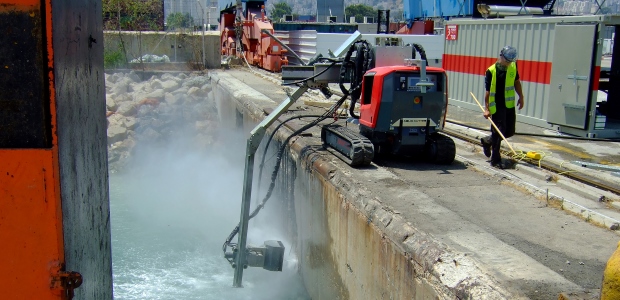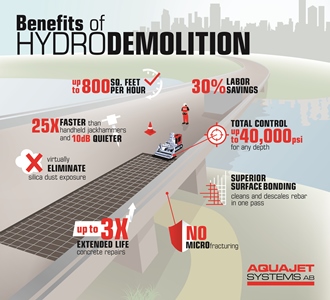
Just Add Water
Robotic hydrodemolition helps to simplify bridge repair.
- By Peter Bigwood
- Jul 15, 2019
According to the U.S. Federal Highway Administration, nearly one out of every three bridges in the nation is rated structurally deficient. Because building new bridges to replace the thousands of old structures isn’t practical, the solution to ensure safety typically lies in replacing old bridge deck concrete with new material. Hydrodemolition, a technique that has been around for more than 30 years, stands out as an ideal method for contractors completing bridge renovation. Its unique manipulation of water is being used worldwide as an efficient concrete repair and rehabilitation technique.
What is Hydrodemolition?
Hydrodemolition is a concrete removal technique used in locations such as bridges, buildings, and airport runways. The method uses high-pressure water jets as powerful as 40,000 psi manipulated by an automated robot to remove layers of deteriorated and damaged concrete. The high-pressure water exceeds the strength of the concrete to widen existing pores and microcracks, breaking it apart in a controlled manner.
Compared to jackhammers, hydrodemolition is an impact-free process, therefore eliminating vibrations that cause microfractures—minuscule cracks in sound concrete that significantly damage the structure’s integrity. The hydrodemolition robot leaves behind a "craggy" profile in the concrete after removing the initial layer of material. The irregular surface provides an ideal texture for bonding to the newly poured concrete.
Alternative techniques such as hand-held breakers tend to leave layers of dust and damaged concrete with small cracks extending as much as 1 inch (10-20 millimeters) into the residual concrete. As a result, the profile could potentially spoil the bonding for new concrete.
Although hydrodemolition's high-powered water jets are devastating to concrete, they do not damage steel rebar. As a natural result of the high-pressure water, rust and scale is removed, leaving the steel clean and intact.
In terms of bridge repair, hydrodemolition techniques reign supreme. The Swedish Cement and Concrete Research Institute reports a repair life expectancy of 21-35 years with hydrodemolition, compared to 7-12 years with mechanical chiseling.

Safety is Key
Whether diesel- or electric-powered, robotic hydrodemolition units are one way to reduce injuries during concrete removal applications. The machines also can reduce both labor costs and insurance premiums compared to traditional methods, such as chipping hammers and hand-held water jetting equipment.
Worker strain is virtually eliminated as operators manage the hydrodemolition equipment through a control pack fastened around their waist. Other hand-held methods produce heavy vibrations that can lead to long-term injuries, such as nerve damage and hand-arm vibration syndrome. These injuries can result in more workers' compensation claims down the line and may cause company insurance premiums to increase. Additionally, remote-controlled equipment doesn't cause operators to fatigue as quickly as hand-held tools, increasing productivity because the machine will perform at a consistent level.
Remote-controlled robots allow operators to monitor their work at a safe distance from hazards such as ledges (common in bridgework), flying debris, and harmful silica dust. In addition, by eliminating the need to stand near a ledge, contractors save time otherwise spent setting up fall abatement systems.
Not only does new hydrodemolition technology help keep workers safe, but also it lowers labor costs while boosting productivity. One operator generally controls the machine and can complete concrete removal tasks as fast or faster than multiple workers. For example, some hydrodemolition robots can remove as much as 800 square feet (74.3 square meters) of concrete bridge deck at a depth of 4 inches (10 centimeters) per hour, a fraction of the time it would take a crew with hand-held breakers.
The secret to the hydrodemolition process is the pressurized water penetration. The combination of high pressure, water volume, and precise, robotic-controlled movements creates a powerful, efficient system. In comparison, operators using hand lances, an alternative method for some concrete removal and cleaning tasks, can't handle the same reaction forces as a robot. This means a significantly higher concrete removal rate from the machine versus the hand lance.
The hydrodemolition machine's stable design maximizes the effectiveness of its high-pressure jets. Innovative technology adjusts and maintains the distance from the nozzle to the point of impact, as well as the nozzle's angle, movement, and water exit speed. The computerized controls also allow consistent results impossible to achieve with a hand lance.
Additionally, hydrodemolition robots' compact nature allows them to reach tight, confined spaces. Various design features and additional attachments also allow for work on any vertical, curved, or horizontal surface. This greatly increases productivity and reduces the number of tools needed on a job site.
Reduced Impacts
Sound, vibrations, lane closures, and project timelines are all factors to consider when selecting the best approach for a bridge repair job. While a crew of 10 laborers might get the job completed, it's noisy, disruptive, and may impact working hours.
Hydrodemolition offers a quieter solution. Hydrodemolition robots generally produce less noise than a hand-held pneumatic tool, and the sound is limited by the machine's hood. Noise from hand-held tools also more easily travels through structures and can be amplified due to echoes. The reduced noise from hydrodemolition robots allows contractors to work in residential areas or avoid busy travel times by working during hours when noise levels are restricted.
In addition to the robot, a complete hydrodemolition system should include a high-pressure power pack and, potentially, a water treatment system to handle the slurry, depending on local regulations. Contractors can pair the robots with self-contained water treatment units that can handle up to 5,000 gallons (18,927 liters) per hour. The 20-foot (6.1-meter) units discharge clean water back into the environment after reducing pH values to 7 and turbidity levels to just 25 ppm. Crews commonly use a trash pump to recover used water and return it to the water treatment unit. A vac-truck can also be used to transport wastewater off site.
A Unique and Unconventional Method
Demand for hydrodemolition robots is growing steadily. The machines' ability to tackle projects in record time while improving safety is appealing to contractors looking for ways to speed up processes while increasing ROI. Also valuable is the machines' ability to remove target concrete while leaving sound concrete and undamaged rebar.
This unique approach to concrete removal will only become more popular. The innovative method is one of contractors' best tools for the efficient, cost-effective, and precise removal of concrete from a variety of structures. It represents one piece of the puzzle in restoring structural integrity to the thousands of bridges in dire need of repair.
This article originally appeared in the July/August 2019 issue of Occupational Health & Safety.